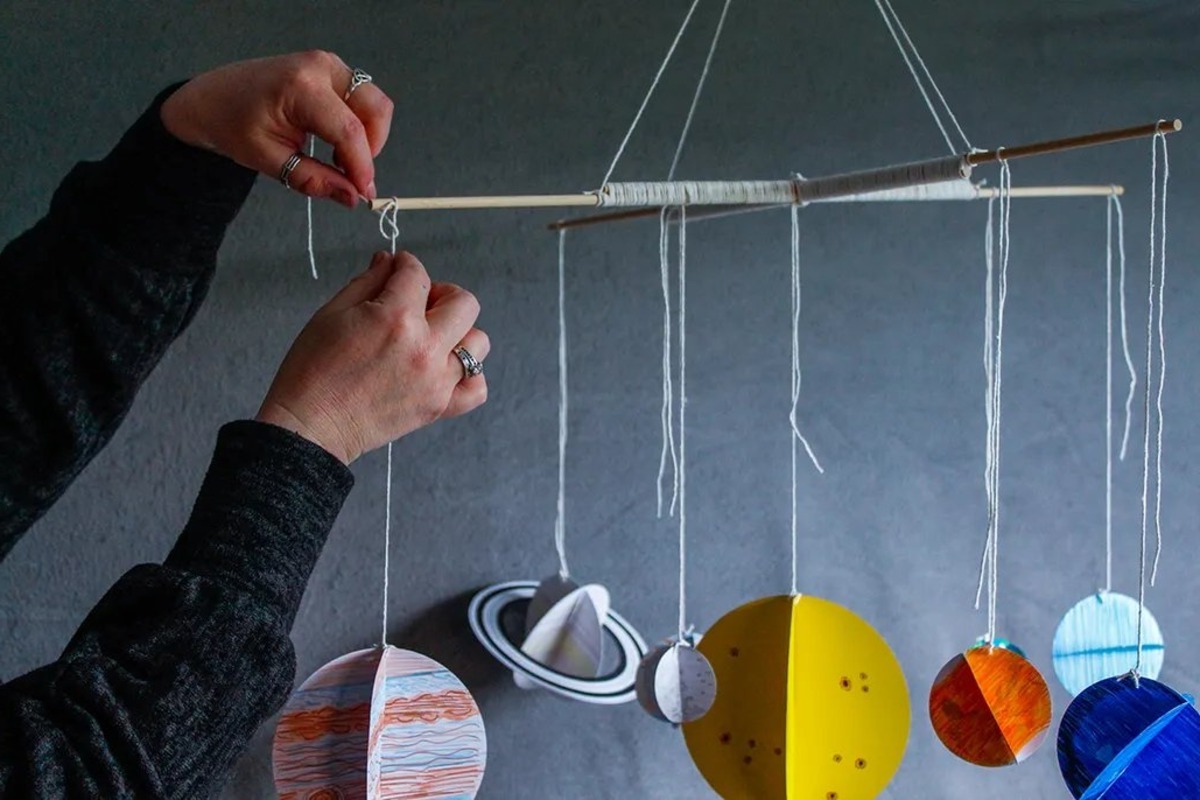Home>Create & Decorate>DIY & Crafts>Crafting Royalty: Hand Knitted Socks Fit For An Emperor


DIY & Crafts
Crafting Royalty: Hand Knitted Socks Fit For An Emperor
Published: February 15, 2024

Content Creator specializing in woodworking and interior transformations. Caegan's guides motivate readers to undertake their own projects, while his custom furniture adds a personal touch.
Discover the ultimate guide to creating regal hand knitted socks fit for royalty. Explore DIY & Crafts techniques to craft socks fit for an emperor.
(Many of the links in this article redirect to a specific reviewed product. Your purchase of these products through affiliate links helps to generate commission for Twigandthistle.com, at no extra cost. Learn more)
Introduction
Crafting royalty-worthy hand knitted socks is a timeless art that combines creativity, skill, and dedication. The process of creating these exquisite garments is not only a labor of love but also a testament to the rich history and tradition of knitting. From the luxurious comfort they provide to the intricate designs that adorn them, hand knitted socks are a true symbol of craftsmanship and attention to detail.
In this comprehensive guide, we will delve into the fascinating world of hand knitted socks, exploring their historical significance, the essential materials and tools needed, the art of choosing the right pattern, and invaluable tips for crafting socks fit for an emperor. Whether you are a seasoned knitting enthusiast or a novice eager to embark on this regal journey, this guide will equip you with the knowledge and inspiration to create masterpieces that exude elegance and sophistication.
Join us as we unravel the captivating history of hand knitted socks and embark on a majestic crafting adventure that will elevate your skills and ignite your passion for the art of knitting. Get ready to immerse yourself in the enchanting realm of yarn, needles, and creativity as we set out to create socks fit for royalty.
Read more: Innovative Summer Hand Washing Techniques
The History of Hand Knitted Socks
Hand knitted socks have a rich and storied history that spans centuries, intertwining with diverse cultures and traditions. The origins of hand knitted socks can be traced back to the ancient civilizations of Egypt and Rome, where early iterations of these garments were crafted using rudimentary techniques and basic materials. As knitting techniques evolved and spread across continents, the art of creating socks flourished, becoming an integral part of various cultural practices and societal norms.
During the Middle Ages, knitting gained prominence in Europe, particularly in regions such as Spain and England. Socks, often referred to as “foot cloths” during this era, were meticulously hand knitted using fine yarns and intricate patterns. The craftsmanship of these socks was highly esteemed, and they were adorned with elaborate designs that reflected the wearer’s social status and wealth.
In the 16th and 17th centuries, hand knitted socks became a symbol of prestige and luxury, especially among the nobility and royalty. Artisans and skilled knitters were commissioned to create opulent socks embellished with precious metals, intricate lacework, and ornate embroidery. These exquisite garments were not only a fashion statement but also a display of affluence and sophistication.
The industrial revolution marked a significant shift in the production of socks, as mechanized knitting techniques emerged, leading to mass production and accessibility. Despite this transformation, the art of hand knitted socks persevered, cherished by individuals who valued the artistry, comfort, and personalized touch that handmade garments offered.
In modern times, hand knitted socks continue to captivate enthusiasts and artisans worldwide, with a resurgence of interest in traditional knitting methods and intricate designs. The allure of crafting socks by hand endures, as it embodies a connection to heritage, creativity, and the timeless appeal of artisanal craftsmanship.
The history of hand knitted socks is a testament to the enduring legacy of this art form, transcending generations and cultures. From its humble origins to its regal associations, the evolution of hand knitted socks reflects the ingenuity, artistry, and cultural significance embedded within this timeless craft.
Materials and Tools Needed
When embarking on the noble endeavor of crafting royalty-worthy hand knitted socks, it is essential to gather the finest materials and tools to ensure the creation of exquisite and enduring garments. The selection of high-quality yarn, appropriate needles, and essential accessories is paramount in achieving superior results that exude elegance and comfort.
Yarn Selection:
The foundation of any hand knitted sock masterpiece lies in the choice of yarn. Opt for luxurious, durable yarns that offer both opulence and practicality. Merino wool, renowned for its softness and insulating properties, is a favored choice for crafting regal socks. Additionally, alpaca and cashmere yarns provide unparalleled comfort and a touch of lavishness, elevating the socks to a realm of unparalleled luxury. Select yarns in rich, regal hues that evoke sophistication and refinement, ensuring that the final creation embodies the essence of royalty.
Needle Selection:
The selection of needles plays a pivotal role in the crafting process, influencing the texture, tension, and overall appearance of the socks. Choose high-quality, smooth needles that facilitate seamless stitching and precise execution of intricate patterns. Double-pointed needles or circular needles, crafted from fine materials such as bamboo or metal, offer exceptional control and maneuverability, enabling the creation of intricate designs with finesse and precision.
Essential Accessories:
In addition to yarn and needles, certain accessories are indispensable for crafting royalty-worthy socks. Stitch markers, tapestry needles, and a reliable pair of scissors are essential tools that streamline the knitting process and ensure meticulous attention to detail. Furthermore, a stitch holder or cable needle may be required for executing complex stitch patterns, adding a touch of regal intricacy to the design.
Embellishments and Accents:
For those seeking to elevate their hand knitted socks to a truly regal status, the inclusion of embellishments and accents can impart a sense of grandeur and opulence. Consider incorporating delicate lace edging, intricate cable motifs, or subtle beading to infuse the socks with an air of sophistication and refinement. Additionally, the inclusion of personalized touches, such as monogrammed initials or embroidered insignias, adds a bespoke element that resonates with regal elegance.
In essence, the materials and tools needed for crafting royalty-worthy hand knitted socks encompass a harmonious blend of exquisite yarns, precision-engineered needles, essential accessories, and optional embellishments. By meticulously selecting these elements, artisans can embark on a majestic crafting journey, weaving together opulence, artistry, and tradition to create socks fit for an emperor.
Choosing the Right Pattern
Selecting the right pattern is a pivotal step in the creation of hand knitted socks fit for royalty. The chosen pattern not only contributes to the aesthetic appeal of the socks but also reflects the artisan’s skill and attention to detail. When seeking the perfect pattern for regal hand knitted socks, several factors come into play, each influencing the overall elegance and sophistication of the final creation.
Intricate Lacework and Embellishments
For those aspiring to infuse their hand knitted socks with an air of opulence and refinement, patterns featuring intricate lacework and embellishments are an ideal choice. Delicate lace motifs, reminiscent of regal tapestries and ornate architecture, add a touch of timeless elegance to the socks. Additionally, the inclusion of subtle beading or embroidery further elevates the pattern, creating a sense of grandeur and luxury that befits royalty.
Read more: How To Build An Adu For Cheap
Regal Cable Motifs
Patterns showcasing regal cable motifs exude a sense of sophistication and regality, evoking images of majestic insignias and ornate detailing. The intertwining cables, reminiscent of ancient heraldic symbols and royal emblems, imbue the socks with a sense of grandeur and heritage. The intricate nature of cable patterns adds depth and texture, elevating the socks to a level of artisanal craftsmanship that resonates with regal splendor.
Timeless Fair Isle Designs
For those drawn to classic elegance and timeless appeal, Fair Isle patterns offer a harmonious blend of tradition and refinement. The intricate colorwork and geometric motifs characteristic of Fair Isle designs evoke a sense of regal heritage and cultural richness. By carefully selecting a color palette that exudes sophistication and grace, artisans can create hand knitted socks that embody the timeless allure of royalty, making a statement of enduring elegance.
Personalized Monograms and Crests
Incorporating personalized monograms or family crests into the sock pattern adds a bespoke touch that resonates with regal sophistication. By integrating initials or insignias into the design, artisans can create socks that not only exude elegance but also carry a sense of lineage and heritage. The inclusion of personalized elements elevates the socks to a level of bespoke luxury, making them truly fit for royalty.
In essence, choosing the right pattern for hand knitted socks fit for an emperor involves a thoughtful consideration of intricate lacework, regal cable motifs, timeless Fair Isle designs, and personalized embellishments. By selecting a pattern that embodies elegance, heritage, and refinement, artisans can embark on a majestic crafting journey, weaving together opulence, artistry, and tradition to create socks fit for royalty.
Tips for Crafting Royalty-Worthy Socks
Crafting hand knitted socks fit for royalty requires a meticulous approach and a dedication to excellence. Here are essential tips to elevate your sock-making endeavors to regal heights:
-
Select Luxurious Yarn: Opt for high-quality yarns such as merino wool, alpaca, or cashmere to imbue your socks with unparalleled comfort and opulence. The choice of yarn sets the foundation for regal elegance and ensures a luxurious wearing experience.
-
Precision in Stitching: Pay meticulous attention to stitch tension and consistency to achieve a polished and regal finish. Consistent and precise stitching enhances the overall appearance of the socks, reflecting a commitment to artisanal craftsmanship.
-
Embrace Intricate Patterns: Choose patterns that exude sophistication, such as intricate lacework, regal cable motifs, or timeless Fair Isle designs. These patterns elevate the socks to a realm of regal splendor, adding depth and elegance to the finished creation.
-
Incorporate Personalized Touches: Infuse the socks with personalized elements such as monograms, family crests, or embroidered insignias to add a bespoke touch that resonates with regal sophistication. Personalization adds a sense of heritage and exclusivity to the socks, making them truly fit for royalty.
-
Attention to Detail: Focus on precision and attention to detail when executing intricate designs and embellishments. Every stitch and embellishment should reflect a commitment to perfection, resulting in socks that exude regal refinement.
-
Seek Inspiration from Regal Imagery: Draw inspiration from regal imagery, such as ornate tapestries, royal emblems, and historic architecture, to infuse your designs with a sense of grandeur and heritage. Let regal aesthetics guide your creative vision, resulting in socks that embody timeless elegance.
-
Incorporate Regal Color Palettes: Select color palettes that evoke regal sophistication, such as deep jewel tones, rich earthy hues, or opulent metallic shades. The choice of colors contributes to the overall regal allure of the socks, elevating them to a status befitting royalty.
-
Finishing Touches: Pay careful attention to the finishing touches, ensuring that the socks are impeccably crafted and exude a sense of regal luxury. Finishing details such as delicate edging, seamless joins, and refined closures contribute to the overall regal aesthetic of the socks.
By embracing these tips and infusing your craftsmanship with a commitment to regal elegance, you can embark on a majestic crafting journey, creating hand knitted socks that epitomize the timeless allure of royalty.
Conclusion
In conclusion, the art of crafting hand knitted socks fit for an emperor is a captivating journey that intertwines heritage, creativity, and regal elegance. From the rich historical tapestry of hand knitted socks to the meticulous selection of materials, patterns, and techniques, this noble endeavor encapsulates the essence of artisanal craftsmanship and timeless sophistication.
As artisans embark on the regal quest of creating socks fit for royalty, they are immersed in a world where opulent yarns, intricate patterns, and personalized touches converge to form masterpieces that transcend mere garments. The culmination of this journey yields socks that not only exude regal splendor but also carry with them a sense of heritage, exclusivity, and enduring elegance.
The history of hand knitted socks serves as a testament to the enduring legacy of this art form, reflecting the evolution of knitting techniques, cultural influences, and the timeless appeal of handmade craftsmanship. From ancient civilizations to modern enthusiasts, the art of hand knitted socks has persevered, captivating generations with its blend of tradition, artistry, and comfort.
The selection of materials and tools, including luxurious yarns, precision-engineered needles, and essential accessories, forms the foundation of regal sock-making. Each element contributes to the creation of socks that embody opulence, comfort, and a touch of regal allure, setting them apart as true works of art.
Choosing the right pattern is a pivotal step in the crafting process, as it infuses the socks with a sense of elegance, refinement, and heritage. Whether adorned with intricate lacework, regal cable motifs, timeless Fair Isle designs, or personalized embellishments, the chosen pattern becomes a canvas for artistic expression, weaving together elements of regal splendor and bespoke luxury.
The tips for crafting royalty-worthy socks serve as guiding principles, imparting wisdom and insight to artisans seeking to elevate their creations to regal heights. From the selection of luxurious yarns to the incorporation of personalized touches, each tip contributes to the meticulous craftsmanship and regal allure of the socks.
In essence, the journey of crafting hand knitted socks fit for an emperor transcends the realm of mere knitting; it embodies a fusion of art, history, and regal elegance. As artisans immerse themselves in this majestic crafting adventure, they breathe life into yarn and needles, weaving together a legacy of opulence, sophistication, and enduring allure. With each stitch and embellishment, they honor the timeless tradition of hand knitted socks, creating masterpieces fit for royalty.













